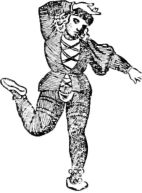Esperance Morris Book vol 1 - online book
A Manual Of Morris Dances Folk-songs And Singing Games With Sheet Music And Instructions
| Share page | Visit Us On FB |
|
6 THE ESPERANCE MORRIS BOOK. |
|||||
|
CHAPTER III.
THE MORRIS STEP. |
|||||
|
" Ami all of their singing was ' Earth, it is well ; Anil all of their dancing was ' Life, thou art goo.l.' "
Bliss Carman.
I
N describing the morris dances it will be well to say before going any further that there is no actual set step which can be distinctly called the morris step. In saying this, I know that I am going against the opinion of some authorities, but my experience now extends over four years, and during that time the Esperance Girls' Club has been in touch with ten different traditional dancers from different counties in England, and our experience has been that each county and almost each neighbourhood has its own particular variant of the dance. For instance, a book |
describing the Headington dances was shown to the men of Bidford, and the description of the step was read to them. They at once said it was all wrong. A dance learned at Ilmington was said by the Headington men not to be a morris at all, though included in a book of morris dances. The Headington men say there is no such thing as the foot being drawn back in the morris dance, but two men living within seven miles of Headington, and who have documentary proof of tradition going back to the year 1700, never used the foot put forward, but in every case did the step, which was one, two, three, and the foot kicked backwards, exactly like the picture of the morris dancers on the stained glass window in Staffordshire. |
||||
 |
 |
 |
|||
|
Again, I had two men up from Northamptonshire, and they did the step hopping Inst on one foot and then with the other leg making two distinct movements, one forward and one to the side, with no sign of a back kick at all. In Lancashire again the step was quite different ; it had evidently been influenced by step dancing, of which it was distinctly reminiscent. One must be prepared, therefore, when going from place to place, and getting fresh dances, to find the actual step different in every place, and yet, curiously enough, when the dance is being danced, one gets very much the same impression of the whole. This, I think, is due a great deal to the vigour, robustness, and general agility with which the dance is danced, and to the ribbons, bells, handkerchiefs, and sticks which accompany it. One can lay down no laws, for I have known the same men change the step on three consecutive \isits to London, so that at the end one could scarcely recognize it as the same step. Another difficulty is that the country dancer at his best is unselfconscious, and dances quite spontaneously, and that merely pulling him up and asking him to repeat the step causes him at once to change, so that even in one evening with one teacher in one dance, one often evolves quite a variant. Of course all this very much adds to the difficulty of writing a description of a dance, because if the first impressions were quite exact, by the time the book was in print the dancer might have changed his mind and be doing a different step. I think it is largely owing to the different dancers who have taught |
them that the sending out of the teachers from the Esperance Club has been such a success, because they have seen so much of the country dancers that they have thoroughly imbibed the spirit of the traditional way of dancing.
At the beginning of each dance the musician plays the first section through once; this is called " Once to yourself." It might be noted here that Morris dance tunes are not of necessity traditional tunes, as the dancers often took popular contemporary tunes and adapted them to their purposes. " Jockey to the Fair" is an instance of this, being undoubtedly a composed tunc which enjoyed great popularity at the end of the eighteenth century.
Miss Florence Warren, our head instructress, has often been asked to write down the dances, exactly as she teaches a class, without technical terms or involved description. This has been done. A shorthand writer took the description of the dances from Miss Warren, just as she gives them to a class of children, to make sure that they are clear and simple. In all of these dances, a " side " consists of six dancers, who stand in the following positions :
&4 54
41 3!
24 14
AUDIENCE. |
||||
 |
|||||
|
5694 |
|||||